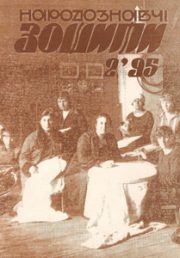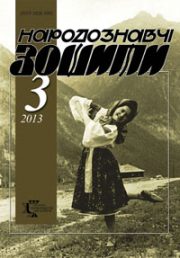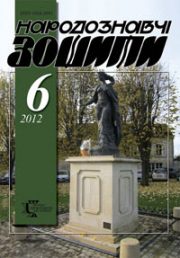The Ethnology Notebooks. 2020. № 5 (155), 1064—1070
UDK 036:908 (282.243.7.03:477.86)”18/19″
DOI https://doi.org/10.15407/nz2020.05.1064
GUIDEBOOKS BY PRUT VALLEY IN MIRROR OF TIME (AT THE AND OF XIX — BEGINNING OF XX CENTURY)
МОVNА Мarianna
- ORCID ID: https://orcid.org/0000-0003-2473-6998
- Junior Researcher of the Vasyl Stefanyk
- National Scientific Library of Ukraine in Lviv
- National Academy of Sciences of Ukraine,
- in Department of Scientific Bibliography,
- 2, Stefanyka str., 79000, Lviv, Ukraine,
- Contacts: e-mail: mari3anna@ukr.net
Abstract. The development of tourism in the second half of the XIX century in the Austro-Hungarian Empire accelerated the emergence of guides to attractive tourist areas, including the Carpathians. The intensification of tourism in the Eastern Carpathians is directly related to the construction of the railway, namely the railway line Stanislaviv — Voronenko in 1894. Since then, the valley of the Prut River, which originates from a spring on the slope of Hoverla and in the upper reaches has a mountainous character, began to apprear as an important tourist attraction, and areas located in the Prut Valley (Delyatyn, Dora, Yaremche, Mykulychyn, Tatariv, Vorokhta), appeared on the pages of tourist guides.
The article for the first time analyzes the factual content of tourist guides through the Prut Valley in the late XIX — early XX century. Their authors were well-known figures of the Polish tourist movement H. Hofbauer, M. Orlovych, as well as members of the Yaremche Club, whose names we have established (J. Skupnevych, A. Sonnenvend, H. Grader, V. Lutsky, B. Skshinsky, R. Steinhraber ets.). All the researched guides (both specially devoted to the Prut Valley and travel books in the Carpathians in general) filled a noticeable gap in the local tourist literature with local tourist information, and also greatly contributed to the intensification of the tourist movement.
The object of the research is the Prut Valley as a tourist region, and the subject — guides to this area. The research methodology is based on the application of the principles of scientificity, objectivity and historicism. In order to solve specific research problems, a comparative-chronological, discource-analysis, anthropological approach was used. The study of Prut Valley guides has never been the subject of special consideration.
Keywords: guidebook, history, tourist movement, Prut Valley, Carpathians, Yaremche, resort, the end of XIX — beg. of XX century.
Received 31.07.2020
REFERENCES
- Makarushka, O. (1909). Doboshanka. Dilo, 170, 1—2; 171, 1—2 [in Ukrainian].
- Movna, M., Havrylyshyn, P., Kardas, M., & Ostanek, A. (Eds.). (2017). Yaremche: the first guide of 1907 or reasons for the history of the local tourist movement. On the side of memory and dialogue… Stanislaviv and the Stanislaviv Land in the era of social and national transformations of the 19th and the first half of the 20th century. Ekonomy — Culture — Religion (Vol. 2, pp. 24—29). Warsaw; Stanislaviv [in Ukrainian].
- Fischer, V. (1911). In defence of the beauty of nature. Nasze Zdroje, 8, 64) [in Polish].
- Hofbauer, H. (Ed.). (1898). Chronicle. Guide to Montenegro. Gazeta Kolomyjska, 53, 3. Review of the book: Guide to Charnohora and the Eastern Beskids. Kolomyja. Trips from railway stations: Nadvirna, Lojova, Delyatyn, Dora, Yaremche, and Mykulychyn (Vol. 2) [in Polish].
- (1909). Holiday-maker. Echa summer. Yaremche in June. Slowo Polskie, 326, 5 [in Polish].
- (1899). Holiday-maker. Correspondence. Gazeta Kolomyjska, 35, 2 [in Polish].
- M., H. (1923). With Montenegro. Gazeta Lwowska, 167, 5 [in Polish].
- (1907). Climatic site «Yaremche» (525 meters above sea level): a guide for visitors. Arranged by the «Yaremchanski Club». Lviv [in Polish].
- (1913). Climatic site «Yaremche» (525 meters above sea level): a guide for visitors (Ed. 2). Appointed by the diligent committee of the editorial board of «Yaremchanski Club». Lviv [in Polish].
- (1898). Montenegro department in Kolomyja. Minutes of the XX Ordinary General Assembly, held in the Hall of the Council of the Coutry on April 11, 1897. Pamietnik Towarzystwa Tatrzanskiego (Vol. 1, pp. 66—77) [in Polish].
- Opalinsky, D. (2013). Travel Guidebooks at Polish lands in period of occupations: historical-sources study. Krosno [in Polish].
- Orlovich, M. (1913). What to see in Galicia?: (directions for tourists). Lviv [in Polish].
- Orlovich, M. (1913). What to see in Galicia?: (directions for tourists) (Ed. 2). Lviv [in Polish].
- (1914). Orlovich, M. Illustrated guide to the Eastern Carpathians of Galicia, Bukovina and Hungary; Lviv Department of the National Tourist Association. Lviv [in Polish].
- (1913). Polish Tourist Association in Lviv. Slowo Polskie, 370, 11). Running news [in Polish].
- Hofbauer, H. (Ed.). (1898). Guide to Montenegro and the Eastern Beskids. Kolomyja. Trips from railway stations: Nadvirna, Lojova, Delyatyn, Dora, Yaremche and Mykulychyn (Vol. 2) [in Polish].
- S., B. (1906). Echa summer. Yaremche. Slowo Polskie, 401, 4) [in Polish].
- Sivicki, K., & Hofbauer, H. (1899). Montenegro department in Kolomyja. Protocol of the XXI Ordinary General Assembly, held in the Hall of the Council of the Country on March 27, (1898). Pamietnik Towarzystwa Tatrzanskiego (Vol. 20, pp. 51, 54—55) [in Polish].
- Smarchevsky, T. (1899). Trip to the Hutsul counry. Gazeta Kolomyjska, 40, 1—2 [in Polish].
- (1913). Running news. Nasze Zdroje, 4, 48 [in Polish].
- (1914). From tourism. Lviv Department of the National Tourist Association. Przeglad Zdrojowo-K№pielowy i Przewodnik Turystyczny, 5, 11. Review of the book: Orlovich, M. Illustrated guide to the Eastern Carpathians of Galicia, Bukovina and Hurgary. Lviv [in Polish].
- (1913). From the life of society. Nasza Turystyka. Supplement to «Nasze Zdroje», 7, 28. Rec. on the book: Climatic site «Yaremche» (525 meters above sea level): a guide for visitors (Ed. 2). Appointed by the diligent committee of the editorial board of «Yaremchanski Club». Lviv [in Polish].







